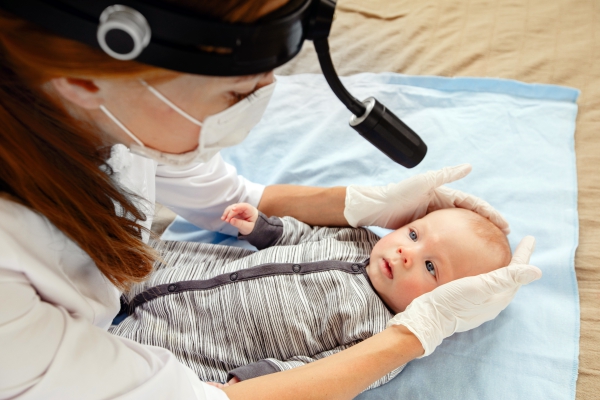What is retinoblastoma?
Retinoblastoma is the most common cancer of the eye among children and makes up about 10-15% of cancers present in the first year of life. It is characterized by the white appearance of the pupil of the eye in a child younger than 2 years. As any other cancers, retinoblastoma can be life-threatening. Retinoblastoma can either be inherited or non-inherited.
The inherited form is associated with mutations in the reproductive cells (sperm and eggs) and there usually is the presence of a positive family history. Non-inherited retinoblastoma is the one that arises due to mutations in non-reproductive cells and therefore is not usually present in the family.
Retinoblastoma arises in about 1 in 15000 live births in the United States. The average age at which the diagnosis is made is around 18 to 20 months. The majority of cases arise before the age of 5 years old. Girls are equally affected as boys and there is no racial predilection.
The cancer usually grows to finally invade the whole eyeball. If left untreated, the cancer can progress and spread to other organs, known as metastasis.
What causes retinoblastoma?
Retinoblastoma is caused by mutations in certain cells of the body. There are two types of retinoblastoma namely: inherited and non-inherited retinoblastoma. Inherited retinoblastoma is caused by mutations in reproductive cells, including sperm and egg cells. This form can be transmitted in the family. On the other hand, non-inherited retinoblastoma is caused by mutations to non-reproductive cells. It is not usually associated with a positive family history.

What are the symptoms of retinoblastoma?
The initial symptom that often leads to seeking medical help is a white eye. This is known as leukocoria.
Other common symptoms include the following:
- Strabismus: This is an abnormal alignment of the eyes. This is noticed as the two eyeballs looking in different directions.
- Nystagmus: This is when your eyes move abnormally involuntarily
- Red eye
- Decreased vision
- Inflamed eye
- Swollen eye
- Painful eye
In advanced cases, if the disease has progressed to later stages, symptoms may include the following:
- Weight loss
- Loss of appetite
- Headache
- Mass in the orbit

How is the diagnosis of retinoblastoma made?
To make the diagnosis of retinoblastoma, your child’s doctor will first start by asking you a series of questions to know more about the progress of the disease as well as a detailed family history. This will include a history of eye tumours, surgical removal of eyeball or any other cancers in childhood of any family member.
To further help in making the diagnosis, he/she will examine your child’s eye for a white pupil. Any misalignment or abnormal eye movements will also be looked for in your child’s eye. Routine blood tests may have to be performed to rule out any other possible conditions. Blood samples may be taken from the patient but also from parents and siblings for analysis of their DNA to identify any possible mutations.

Imaging tests may be requested to visualize the structures inside of the orbit as well as other structures surrounding the eye. Imaging techniques include the following: ultrasound, computed tomography (CT) scan and magnetic resonance imaging (MRI).
How is retinoblastoma treated?
The goals of the treatment of retinoblastoma include the following:
- Eradication of the disease and prevention of death from the condition
- Prevention of loss of vision as much as possible
- Prevention of late complications
There are various treatment options available for the treatment of retinoblastoma. Your doctor knows best which treatment will suit you the most depending on the size of the tumour, its location, the patient’s age and extent of loss of vision.
Treatment options include the following:
- Radiation therapy: This treatment modality involves the use of high energy beams to destroy cancer cells. In retinoblastoma, two types of radiation therapy are used including; internal radiation (brachytherapy) and external beam radiation. In internal radiation therapy, the device used for treatment is inserted into or near to the tumour. In contrast, external beam radiation used a machine that delivers the high energy beams from outside of your body.
- Chemotherapy: In this treatment option, chemotherapy drugs are used to kill cancer cells. These medications can be taken in the form of pills or through vein injections. This treatment option can also be used in conjunction with other treatments as it can help to shrink the tumour. This is also used to treat cancer that has spread to other parts of the body. In some cases, the chemotherapy medications may be delivered directly into the affected eye.
- Laser therapy: Laser beams can be used to treat retinoblastoma by destroying blood vessels supplying the cancer. As soon as the cancer is cut off from essential nutrients and oxygen, the cancer cells eventually start to die.
- Cryotherapy: In this treatment modality, a special device that uses extreme cold is used to kill cancer cells.
- Enucleation: In this surgical procedure, the eye and a portion of the optic nerve is removed leaving behind the muscles and some surrounding structures in the orbit. After removal, an eye implant may be placed in the orbit and attached to the muscles of the eye. This enables movement of the eye implant similar to the natural eye. The eye implant, however, does not enable vision.

What are the possible complications of retinoblastoma?
Complications of retinoblastoma may include the following:
- Spread of cancer to other parts of the body
- Blindness
- Increased risk of having other cancers
- Recurrence of retinoblastoma
Prognosis
The clinical course of retinoblastoma is favourable if medical intervention is initiated as early as possible. In the United States and Great Britain, more than 85% of patients with retinoblastoma survive. More than 90% are cured if the disease has not progressed to the nerve found at the back of your eye known as the optic nerve.


Source:
Isidro, M., 2019. Retinoblastoma Clinical Presentation
Kaufman, P., 2018. Retinoblastoma: Clinical presentation, evaluation, and diagnosis
Isidro, M., 2019. Retinoblastoma Treatment & Management
Kaufman, P., 2018. Retinoblastoma: Treatment and outcome





